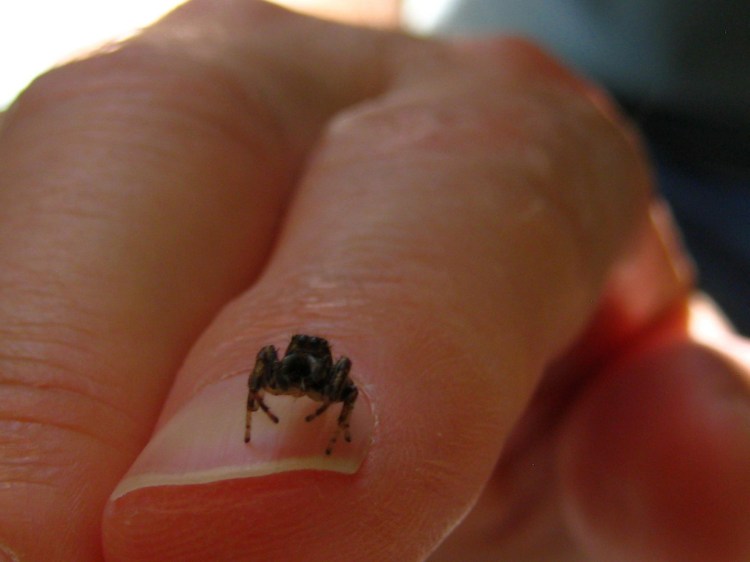Regular readers of Backyard Naturalist know that I have a special place in my, well, backyard for spiders. For those who share the fascination, I thought I’d pass along a few notes from a study by a team of European and American scientists, “Record breaking achievements by spiders and the scientists who study them.”
The researchers combed through decades worth of spider studies to try to identify extremes of spider biology and behavior. Part of their purpose was to provide some popular information that would help boost their contention that organismal biology is an important field in the natural sciences. In a nutshell, organismal biology is “the study of structure, function, ecology and evolution at the level of the organism,” according to the Cornell University Department of Ecology and Evolutionary Biology. The researchers argue that “organismal biology can facilitate scientific observation, discovery, research, and engagement, especially when the organisms of focus are ubiquitous and charismatic animals such as spiders.”
I always get amused when scientists — who claim that impassive rational objectivity is central to their way of knowing — leak highly subjective descriptors such as “charismatic” into their reports. Science is human after all. Here are a few of their arachnid highlights.
The largest living spider by mass is the Goliath bird-eater (Theraphosa blondi) in the tarantula family. An individual reared in captivity weighed nearly 6 ounces, and had a leg span of 28 centimeters, or upwards of 11 inches. Goliath bird-eaters are native to northern South America, not Maine. The largest known leg span occurred on a giant huntsman spider (Heteropoda maxima) from a cave in Laos — 30 cm, or almost a foot from toe to toe. Not found in Maine.
In most spider species, the females are larger than the males. The smallest adult female spider on record is an Anapistula ataecina individual (in the family Symphytognathidae) found in a cave in Portugal. She had a total body length of 0.43 millimeters, or under 2 one-hundredths of an inch. No A. ataecina male has been found yet. The smallest adult male spider, in the researchers’ reckoning, was a Patu digua individual (also in the Symphytognathidae family) found in Colombia with a TBL of 0.37 mm.
The largest web by area ever measured was 2.8 square meters, or yards, spun by a Darwin’s bark spider (Caerostris darwini), an orb-weaving spider discovered fairly recently in Madagascar. The Darwin bark spider’s anchor lines can bridge more than 25 yards.
The smallest known webs are spun by members of the Symphytognathidae family, at less than 10 mm, or well under half an inch in diameter.
Hardly any spiders are dangerous to humans because their toxins, with rare exceptions, are ineffective on our metabolisms and their fangs are just too small to break human skin. But among the few that are, the Australian funnel-web spiders (family Hexathelidae) are generally considered the most dangerous. Just 0.2mg/kg of the venom of the male Sydney funnel-web spider (Atrax robustus) can kill a human; reports indicate that in worst-case bites, death can occur within 15 minutes. The researchers point out that since the development of antidotes against funnel-web spider envenomation (from roughly the 1970s and ’80s on), no fatal bites have been reported. These spiders live in Australia, not North America. Spiders with venom dangerous to humans in North America are the widow spiders (Latrodectus) and brown recluse (Loxosceles), but deaths are extremely rare. Maine is too cold for widow and recluse spiders, with rare summer visitor exceptions.
Most spiders live solitary lives either hunting or spinning their own webs. But a few species, categorized as social spiders, live in communal webs. Among these, the largest colonies found have been built by members of Anelosimus eximius (in the Theridiidae family of cobweb weavers, which includes the common house spiders that probably live with you). A. eximius webs range in length from about 4 to 10 inches containing just a few individuals, to 2-3 yards and more containing thousands of individuals; an estimate for one such colony was 50,000 inhabitants. This is in South America, not Maine.
The coldest place spiders have been found is the town of Oymyakon, in eastern Russia, the coldest inhabited area of Earth (absolute minimal temperature minus 96 Fahrehnheit recorded in 1924). Fifty-five spider species have been documented living in Oymyakon and surroundings. The hottest place spiders have been found living is Death Valley, California, where ground temperature of 134 F has been recorded. Wolf spiders, mesh-web weavers, jumping spiders, crab spiders and cellar spiders, all of whom are also found in Maine, have been identified in Death Valley.
No spiders live permanently in water. The Desis marina spider in the South Pacific builds an underwater nest, in which one spider stayed submerged for 19 days, and the diving bell spider (Argyroneta aquatica) of central Europe and Asia spends much of its life underwater inside an air bubble attached to its legs and body. But spiders breathe air, not water. Sea spiders are not spiders, just similar-looking distant relatives.
No spiders are known to be native to Antarctica. But spider bodies have been found there. They’re practically everywhere.
“Record breaking achievements by spiders” appeared in the October 2017 issue of the journal PeerJ.
Send questions/comments to the editors.



Comments are no longer available on this story